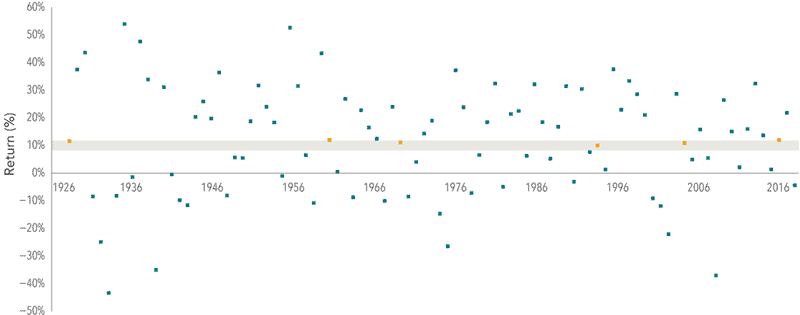- You are here:
- Home »
- Blog »
- Investment Advice »
- The Uncommon Average

The Uncommon Average
The US stock market has delivered an average annual return of around 10% since 1926. [1] Is this an uncommon average? Short-term results may vary, and in any given period stock returns can be positive, negative, or flat.
“I have found that the importance of having an investment philosophy—one that is robust and that you can stick with— cannot be overstated.”
—David Booth
Expectations And The Uncommon Average
When setting expectations, it’s helpful to see the range of outcomes experienced by investors historically. For example, how often have the stock market’s annual returns actually aligned with its long-term average?
Exhibit 1. – S&P 500 Index Annual Returns, 1926–2018
Exhibit 1 shows calendar year returns for the S&P 500 Index since 1926. The shaded band marks the historical average of 10%, plus or minus 2 percentage points. The S&P 500 Index had a return within this range in only six of the past 93 calendar years. In most years, the index’s return was outside of the range—often above or below by a wide margin—with no obvious pattern. For investors, the data highlight the importance of looking beyond average returns and being aware of the range of potential outcomes.

Tuning In To Different Frequencies
Despite the year-to-year volatility, investors can potentially increase their chances of having a positive outcome by maintaining a long-term focus. Exhibit 2 documents the historical frequency of positive returns over rolling periods of one, five, and 10 years in the US market. The data show that, while positive performance is never assured, investors’ odds improve over longer time horizons.
Exhibit 2. Frequency of Positive Returns in the S&P 500 Index, Overlapping Periods: 1926–2018

Conclusion
While some investors might find it easy to stay the course in years with above average returns, periods of disappointing results may test an investor’s faith in equity markets. Being aware of the range of potential outcomes can help investors remain disciplined, which in the long term can increase the odds of a successful investment experience. What can help investors endure the ups and downs? While there is no silver bullet, understanding how markets work and trusting market prices are good starting points. An asset allocation that aligns with personal risk tolerances and investment goals is also valuable. By thoughtfully considering these and other issues, investors may be better prepared to stay focused on their long-term goals during different market environments, and avoid the temptation of the uncommon average.
Footnotes
[1]. As measured by the S&P 500 Index from 1926–2018.
About the Author Doug Finley
Douglas Finley, MS, CFP, AEP, CDFA founded Finley Wealth Advisors in February of 2006, as a Fiduciary Fee-Only Registered Investment Advisor, with the goal of creating a firm that eliminated the conflicts of interest inherent in the financial planner – advisor/client relationship. The firm specializes in wealth management for the middle-class millionaire.
Related Posts
Why Stick with a Globally Diversified Portfolio? Principle 7 in Evidence-Based Investing
What Really Drives Higher Expected Returns? Principle 5 in Evidence-Based Investing
Understanding How Markets Work for You: Principle 4 in Evidence-Based Investing
Trying To Outguess the Market Has No Role: Principle 2 in Evidence-Based Investing
Embrace Market Pricing: Principle 1 in Evidence Based Investing
The Bumpy Road to the Market’s Long-Term Average
Don’t Let A Market Timer Gamble with Your Life Savings
How Has Market Behavior Evolved For Emerging Markets Investing?
Session expired
Please log in again. The login page will open in a new tab. After logging in you can close it and return to this page.
